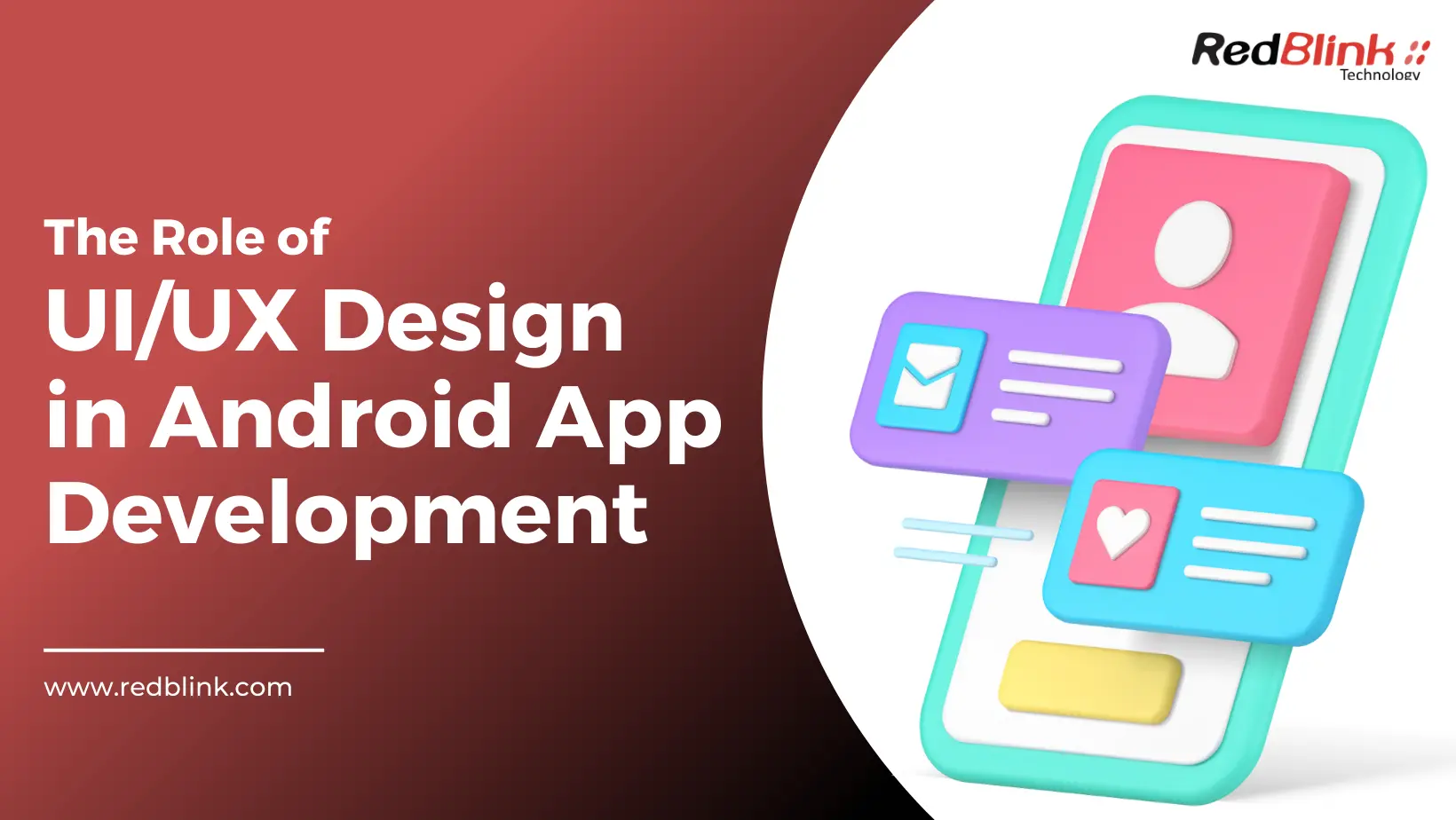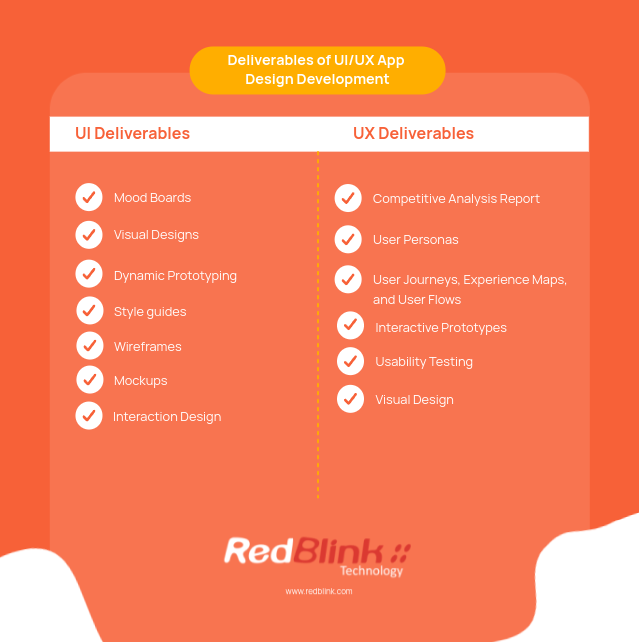UI/UX Design in Android App Development
In the ever-evolving and competitive digital world, mobile applications have emerged as a pivotal device for businesses seeking to forge connections with their customer base and attain exponential growth.
Android applications, in particular, proffer a vast user base and a thriving ecosystem for businesses to tap into. However, the development of an Android app that not only fulfills functional requisites but also captivates users and propels business triumph necessitates meticulous contemplation of User Experience (UX) and User Interface (UI) design.

The significance of UI/UX design in the domain of Android app development cannot be overstated, especially for businesses aiming to distinguish themselves from the crowd and deliver exceptional experiences to their customers. A well-designed app not only amplifies usability but also fosters affirmative user interactions amplifies engagement, and ultimately engenders customer satisfaction and unwavering loyalty.
Key Facts:
Let’s look at some of their stats:
- 86% of marketers consider improvements in speed for mobile apps and sites are helping in increasing customer satisfaction scores. (Source: ValueCoders)
- It has been estimated that around 90% of users have stopped using a mobile app because of poor performance. (Source: ValueCoders)
- 86% of users deleted or uninstalled at least one mobile app because of problems with its performance. (Source: Northern Arizona University)
In this blog, we shall embark upon a journey to explore the pivotal role that UI/UX design assumes in Android app development, delving from a business standpoint. We will delve deep into the strategic advantages of investing in UI/UX design, the profound impact it exerts on customer acquisition and retention, and how it can render your business distinct amidst the cutthroat milieu of the Android app market.
What is UI Design in a Mobile Application?
UI, an abbreviation for User Interface, represents the way users interact with mobile apps. The design of a mobile app’s user interface aims to facilitate easy, enjoyable, and effective interactions between users and the app.
In the world of information technology, UI refers to devices that enable users to interact with monitors, screens, or mobile devices.
The primary goal of mobile app UI principles is to provide the best possible user interaction experience.
What is UX Design in a Mobile Application?
User Experience (UX) revolves around creating a system that offers users the best possible experience.
The principles of mobile app UX aim to transform customers into loyal advocates by providing a positive experience to them. UX is responsible for guiding users through their journey within the mobile app or website, which ultimately determines the success of the business.
Mobile app UI and UX design go hand in hand as they are closely intertwined. To achieve success, an app must strive to excel in both areas.
What are the Deliverables of UI/UX App Design Development?
UI/UX designers go through several phases while creating an intuitive UI/UX Android app. Throughout the UI and UX design process, different deliverables are generated for clients.

These deliverables serve various purposes, such as facilitating effective communication, documenting the project, and presenting ideas in a structured manner.
Both UI and UX have their distinct deliverables, which we will explore further to gain a better understanding of the role of mobile app UI/UX design in the overall mobile app design and development process.
UI Deliverables
- Mood Boards: Mood boards serve as a means to effectively communicate innovative ideas to a wide audience. They facilitate client understanding of the app concept that designers will be working on.
- Visual Designs: Visual designs play a vital role in comprehending the impact of various design elements. Elements such as photography, typography, space, colors, layouts, and images are better grasped through visual designs, allowing for a more comprehensive understanding of their effects.
- Dynamic Prototyping: Dynamic prototypes are another important UI deliverable. These prototypes contribute to enhancing the overall functionality of the app and enable ongoing improvements as necessary. With dynamic prototypes, the UI can be developed according to the specific desires and requirements of the clients.
- Style Guides: Style guides provide comprehensive guidelines for maintaining visual consistency throughout the app. They define the typography, color schemes, iconography, and other design elements that should be followed consistently across different screens and interactions.
- Wireframes: Wireframes are basic, low-fidelity representations of the app’s layout and structure. They outline the placement of key elements and content without focusing on visual aesthetics. Wireframes help in planning the app’s functionality and user flow.
- Mockups: Mockups are high-fidelity representations of the app’s user interface. They incorporate visual design elements, such as colors, typography, and graphics, to showcase how the final app will look. Mockups provide a more realistic visual representation for client and stakeholder feedback.
- Interaction Design: Interaction design focuses on defining the behavior and responsiveness of the app’s interface. It involves creating interactive prototypes or animations that demonstrate how users will engage with the app’s features and navigate through different screens.
- Icon Design: Icons play a vital role in enhancing the visual appeal and usability of an app. Icon design involves creating a set of cohesive and intuitive icons that represent actions, features, or concepts within the app. These icons contribute to the overall user experience and aid in navigation.
- Responsive Design: In today’s multi-device landscape, responsive design has become very important. It involves designing and optimizing the app’s user interface to adapt seamlessly across various screen sizes and orientations, ensuring a consistent and optimal user experience across different devices.
- Accessibility Design: Considering accessibility is essential to ensure that the app is usable and inclusive for all users, including those with disabilities. Accessibility design involves incorporating features and design considerations that enable users with visual, auditory, or physical impairments to effectively use the app.
UX Deliverables
- Competitive Analysis Report: The purpose of the competitive analysis report is to evaluate the level of competition your app faces. If your app operates in a highly competitive market or is unprepared to outperform its competitors, all efforts might go in vain. Conducting a competitive analysis can identify the strengths and weaknesses of your competitors’ apps.
- User Personas: Creating buyer personas not only helps in understanding customer behavior but also facilitates effective communication with clients. The UX process involves conducting user research to gain insights into behavioral patterns.
- User Journeys, Experience Maps, and User Flows: Experience maps provide a comprehensive view of users’ overall behavior and interactions with a product. They showcase expectations, time spent, reactions, thoughts, and needs, among other factors. User journeys, or user flows, describe how users interact with a product at different stages. Depending on the product, these can include both current and potential interactions.
- Interactive Prototypes: This is another essential deliverable in the UX process. Utilizing rudimentary prototypes can save significant time and effort while still effectively fulfilling their purpose. Prototypes help demonstrate how the final product will function once fully developed, enabling designers to communicate their ideas more effectively.
- Usability Testing: It is a crucial UX deliverable that involves observing and analyzing how users interact with the app or website. By conducting usability tests, designers can gather valuable feedback on the usability and effectiveness of the user interface. This feedback helps identify areas for improvement and ensures a more user-friendly experience.
- Visual Design: This encompasses the aesthetic aspects of the app or website, including color schemes, typography, icons, and overall branding. It focuses on creating a visually appealing and cohesive interface that aligns with the target audience and brand identity. Visual design enhances the overall user experience and helps establish a strong visual identity for the product.
The Business Value of UI/UX Design in Android App Development
Creating an exceptional user experience is essential for businesses to thrive and succeed. Users demand seamless, intuitive, and visually appealing interfaces that not only meet their needs but also exceed their expectations.
Let’s explore the significant business value of incorporating UI/UX design principles into your Android app development strategy.
-
Enhance User Satisfaction and Engagement
The success of any app hinges on its ability to satisfy and engage users. UI/UX design plays a crucial role in achieving this goal. By employing user-centered design principles, you can create an app interface that is intuitive, easy to navigate, and visually appealing. A seamless user experience not only delights users but also keeps them engaged, leading to increased usage, positive reviews, and higher customer satisfaction.
But why is user satisfaction so important? Satisfied users are more likely to become loyal customers, recommend your app to others, and even advocate for your brand. If your business mobile app lies in a highly competitive niche then user satisfaction can be the key differentiator that sets your app apart from the rest.
-
Differentiate from Competitors
Speaking of differentiation, UI/UX design is an excellent avenue for setting your Android app apart from competitors. By investing in a well-designed and user-friendly interface, you can create a unique brand identity and establish a competitive edge.
When users are faced with multiple app options offering similar features, they often turn to design as a deciding factor. A visually appealing and intuitive interface can make a lasting impression, making users more likely to choose your app over competitors. Stand out from the crowd by delivering an exceptional user experience through thoughtful UI/UX design.
-
Increase Conversion Rates and Revenue
When you own or manage a business you always seek good conversions and revenue. A well-designed app interface has the power to influence user behavior and drive conversions. By optimizing the user flow, simplifying the conversion process, and strategically placing calls to action, you can guide users towards desired actions, such as making purchases, signing up for services, or subscribing to premium features.
Moreover, a positive user experience instills trust and confidence in users, increasing their willingness to engage with your app and make transactions. With UI/UX design best practices, you can create an app that drives revenue and boosts profitability.
-
Reduce Development and Maintenance Costs
Contrary to popular belief, investing in UI/UX design can actually help you save costs in the long run. By incorporating user-centered design principles early in the development process, you can identify and address usability issues, design flaws, and user pain points before they become costly problems.
A well-designed app reduces the need for extensive post-launch fixes and updates, ultimately saving development and maintenance costs. Additionally, by providing a seamless user experience, you can minimize user support requests and inquiries, freeing up valuable resources to focus on enhancing your app’s features and expanding your business.
-
Improve Customer Loyalty and Retention
Building customer loyalty is vital for sustained success in the app market. A loyal user base not only generates repeat business but also serves as a brand ambassador, driving organic growth through positive word-of-mouth.
A key driver of customer loyalty is a positive user experience. When users find an app that consistently meets their needs, provides value, and offers an enjoyable experience, they are more likely to remain loyal and continue using the app over time.
By prioritizing UI/UX design, you can foster strong relationships with your users, enhancing customer retention and maximizing the lifetime value of each customer.
Key Considerations for UI/UX Design in Android App Development
Looking to start an Android App development and aiming for a seamless and engaging user experience?
The success of your app greatly depends on how well you incorporate UI/UX design principles. With millions of apps available in the market, it’s essential to stand out and deliver an exceptional user experience that keeps your users engaged and satisfied.
In this section, we will explore the key considerations for UI/UX design in Android app development.
-
User Research and Understanding
To design an Android app that resonates with your target audience, conducting thorough user research is vital. This involves utilizing various methods such as surveys, interviews, and analytics data analysis to gather insights into user behavior, preferences, and pain points.
Understanding your users on a profound level sets a solid foundation for creating a user-centric app that addresses their specific requirements and delivers a delightful experience.
-
Define User Personas and User Journeys
Once you have gathered user research data, the next step is to define user personas and map out user journeys.
-
- User personas are fictional representations of your target users, encapsulating their characteristics, goals, motivations, and pain points. These personas help you empathize with your users and design an app that caters to their unique needs.
- User journeys, on the other hand, illustrate the step-by-step interactions users have with your app, from initial discovery to completion of tasks.
- Mapping out user journeys allows you to identify pain points of your mobile app, areas of friction, and opportunities for improvement. This way you can create a seamless and intuitive user experience.
-
Wireframing and Prototyping
Wireframing and prototyping are essential steps in the Android app design process. Tools such as Sketch, Figma, or Adobe XD can be used for wireframing.
These tools allow designers to create low-fidelity visual representations of the app’s layout, focusing on the structure and placement of key elements and features.
Prototyping tools like InVision, Marvel, or Proto.io enable designers to add interactivity, simulating the app’s functionality and user flows for testing and feedback.
Creating prototypes can help in identifying usability issues early on and making necessary adjustments, saving time and resources in the development phase.
-
Visual Design and Branding
The visual design and branding of your Android app significantly impact user perception and engagement.
Using tools like Adobe Photoshop or Illustrator, designers can create visually appealing interfaces that align with your brand identity.
Adhering to the Material Design guidelines provided by Google ensures a consistent and intuitive experience across different Android devices.
-
Usability Testing and Iterative Improvement
Usability testing plays a crucial role in refining your Android app’s user experience.
Tools like UserTesting, Optimal Workshop, or Maze enable you to observe real users interacting with your app and gather feedback.
Through iterative improvement, you can make incremental changes based on user feedback, ensuring your app continuously evolves and meets user expectations.
Usability testing and iterative improvement can create an Android app that is user-friendly, intuitive, and capable of delighting your target audience.
FAQs About the Importance of UI/UX Design
-
Why is UI/UX design important for business success?
UI/UX design directly impacts user satisfaction and engagement with an app. A well-designed app that provides a positive user experience can significantly contribute to customer loyalty, higher usage rates, and positive reviews. It differentiates a business from its competitors and can lead to increased customer acquisition and retention.
-
What tools can be used for UI/UX design in Android app development?
There are several tools available for UI/UX design in Android app development. Some popular options include Sketch, Figma, Adobe XD for wireframing and prototyping, and Adobe Photoshop or Illustrator for visual design. Additionally, tools like InVision, Marvel, or Proto.io can be used for creating interactive prototypes to test and gather feedback from users.
-
Can UI/UX design impact app monetization and business revenue?
Yes, UI/UX design can have a significant impact on app monetization and business revenue. A well-designed app that delivers a positive user experience is more likely to attract paying customers, encourage in-app purchases, and generate higher revenue through increased usage and user engagement.
-
Is UI/UX design a one-time process or an ongoing effort?
UI/UX design is an ongoing effort that should be integrated throughout the entire app development lifecycle. It starts with user research and continues through the wireframing, prototyping, visual design, and usability testing stages. Additionally, continuous monitoring of user feedback and iterative improvements are necessary to adapt the app to evolving user needs and ensure its long-term success.
Looking to Hire UI/UX Designers for Android App Development?
To ensure effective UI/UX design in Android app development, businesses should consider hiring skilled UI/UX designers who possess expertise in creating visually appealing and user-friendly interfaces. RedBlink UI/UX designers, known for their proficiency and experience, can be an excellent choice for businesses seeking top-notch design solutions.
With RedBlink UI/UX designers along with Android app developers, you can expect innovative and immersive design solutions that align with your business goals and user expectations. Their expertise in user research, wireframing, prototyping, visual design, and usability testing can help you deliver exceptional user experiences and achieve your desired app performance. Check out our portfolio section to get an overview of their skill and expertise.
Don’t underestimate the impact of UI/UX design on your Android app’s success. Take the leap and hire RedBlink UI/UX designers to unlock the full potential of your app and elevate your business to new heights. Invest in UI/UX design today and reap the rewards of a well-designed and user-centric Android app. Schedule an appointment today!

Director of Digital Marketing | NLP Entity SEO Specialist | Data Scientist | Growth Ninja
With more than 15 years of experience, Loveneet Singh is a seasoned digital marketing director, NLP entity SEO specialist, and data scientist. With a passion for all things Google, WordPress, SEO services, web development, and digital marketing, he brings a wealth of knowledge and expertise to every project. Loveneet’s commitment to creating people-first content that aligns with Google’s guidelines ensures that his articles provide a satisfying experience for readers. Stay updated with his insights and strategies to boost your online presence.
